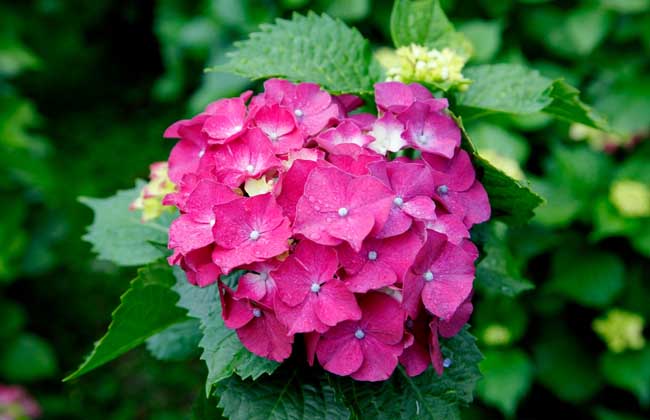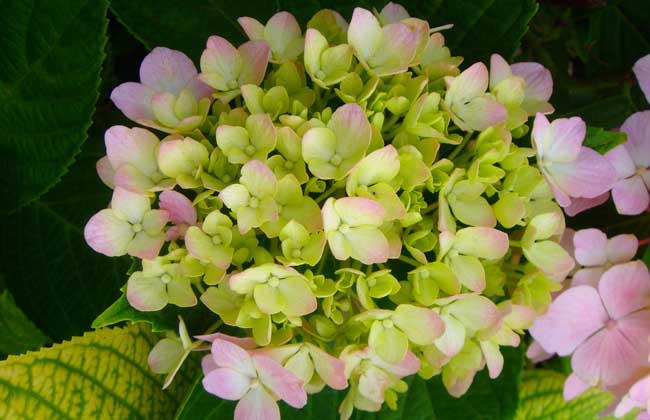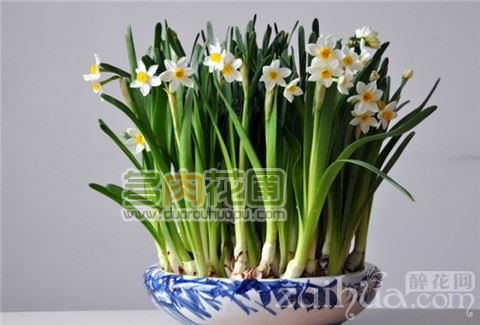Why don't hydrangeas bloom?
Hydrangea is the eight Immortals, also known as Ziyang Flower, Yin Hydrangea, the florescence is usually from June to July. Hydrangea has a stout stem, hypertrophic leaves and dark green leaves but does not bloom, which may be caused by the following four reasons:
First, there is no purposeful pruning of the potted plant, and it is usually necessary to cut the end of the branch in time after the flower fade to promote the division of new branches. when the new branch grows to 8-10 cm, it can be cut short again, which can promote the development and enrichment of lateral buds as early as possible. only in this way can flowers grow in the following year; that is to say, through topping to inhibit the vegetative growth of the plant, to promote its multiple lateral branches, pregnant flower buds.
Second, the proportion of fertilization types is out of balance, which may be too much nitrogen fertilizer and less phosphorus and potassium fertilizer, resulting in its vegetative growth is too prosperous, which is not conducive to flower bud gestation, so that the plant can not bloom normally in the second and third year.
Third, it is possible to water too much, and when the new shoots of the plants grow to a certain length, they should be given appropriate "buckle water" to inhibit their vegetative growth and promote flower bud differentiation.
Fourth, the light time control is not in place, Hydrangea is a short-day plant, maintain darkness for more than 10 hours a day, about 6 weeks to form flower buds. After 6-8 weeks of cool (5-7 ℃), the plant was placed at a temperature of 20 ℃ to promote flowering. When the inflorescence could be seen, the temperature was reduced to about 16 ℃, so that it could blossom for about 2 weeks.
When does hydrangea blossom? why doesn't hydrangea blossom?
Hydrangea is a famous ornamental plant in the Yangtze River valley, also known as eight immortals, powder ball, grass hydrangea and so on. The flowers are beautiful in color, plump, large and beautiful, and the flowers can be red and blue. When will hydrangea blossom? Why don't hydrangeas bloom?

When does hydrangea blossom:
Hydrangea usually blossoms from June to August, and the time from flowering to flower shedding is about 25 days. The color of hydrangea is pink, light blue or white, but the color of hydrangea varies with the pH of the soil or medium. Aluminum sulfate can be applied during bud formation in order to deepen blue, and lime can be applied in the soil to keep pink.
Why doesn't hydrangea blossom:
1. Excessive nitrogen fertilizer: nitrogen fertilizer is the main fertilizer in the early stage of Hydrangea flower bud differentiation, and phosphorus fertilizer is the main fertilizer in the differentiation stage, but excessive application of nitrogen and phosphorus fertilizer in autumn and winter will cause plant excess nutrition, growth inhibition, flower bud differentiation and affect flowering in the second year.
2. Weak light: the family cultivation of Hydrangea is limited by conditions and receives less light, which will cause the leaves to grow excessively and grow poorly. The nutrient consumption of leaves is too large, and the nutrition is insufficient during flower bud differentiation, which affects flowering.
3, the light is too long: Hydrangea is a short-day plant, the light time during the flower bud differentiation period can not be more than 10 hours, the eight immortal flowers placed in the room, the light exposure for a long time at night will increase the light and affect the flower bud differentiation.
4. Pruning is uncomfortable: the flowering period of Hydrangea is from June to August, and the flower branches should be pruned after flowering to reduce the loss of nutrients. If the plant is too prosperous and cut again in early spring, it is difficult to form flower branches from June to August, resulting in a decrease in flowering or no flowering.
How to cultivate hydrangea:
1. Soil: loose, fertile and well-drained sandy loam is better for hydrangea, but the color of hydrangea changes greatly due to the change of soil pH. Aluminum sulfate can be applied during bud formation in order to deepen blue, and lime can be applied in soil to keep pink.
2. Watering: the potted soil of hydrangea should be kept moist, but it should not be watered too much, especially in the rainy season to prevent rotting roots caused by waterlogging. It is better to dry indoor potted plants in winter. If it is too wet, the leaves will rot easily.
3. Lighting: Hydrangea is a short-day plant, usually cultivated to avoid the hot sun, 60% to 70% shade is the best. When the light is too strong in midsummer, proper shading can prolong the flowering period.
4. Temperature: the optimum temperature for the growth of hydrangea is 18-28 ℃, and the winter temperature is not lower than 5 ℃. Flower bud differentiation takes 6-8 weeks under the condition of 5-7 ℃. The temperature of 20 ℃ can promote flowering, maintain 16 ℃ after anthesis, prolong the viewing period, and pay attention to the rapid discoloration of flowers caused by high temperature.
5. Fertilization: hydrangea should generally apply thin pancake fertilizer and water every 15 days or so. In order to keep the basin soil acidic, 0.2% ferrous sulfate should be added to turn it into alum fertilizer when applying liquid fertilizer, and 0.5% superphosphate soaking solution should be applied twice during the bud period.
6. Pruning: after Hydrangea blossoms, attention should be paid to the removal of flower stems to promote the production of new branches. Proper pruning can keep the plant shape graceful. In early spring and March, the diseased and weak branches should be cut off from the base, leaving 3-5 strong main branches and truncated, each with 2-3 buds.
7. Insect pests: Hydrangea is mainly caused by wilt, powdery mildew and leaf spot, which can be controlled by spraying 65% Dessen zinc wettable powder 600 times. Insect pests are harmful to aphids and bug bugs and can be sprayed with 1500 times of omethoate EC.
8. Change the basin: hydrangeas generally turn the basin and change the soil once a year, combined with changing the basin to cut off the rotten roots, rotten roots and overlong roots. After the plant is moved into the new pot, the soil should be compacted, then watered thoroughly, placed in a shaded place for about 10 days, and then moved outside for normal management.
Why doesn't hydrangea bloom? what if hydrangea doesn't blossom?
Hydrangea is eight Immortals, also known as Ziyang Flower, Yin Hydrangea, flowering period is usually from June to July, Hydrangea stem stout, leaves hypertrophy, leaf color thick green, but many hydrangeas do not bloom, then why does Hydrangea not bloom? What if hydrangea doesn't blossom?
Potted hydrangea has not been pruned:
It is usually necessary to cut the tip of the branch in time after the flower fade to promote the division of new branches. when the new branch grows to 8-10 cm, it can be cut short again, which can promote the lateral bud on it to develop and enrich as soon as possible, so that it can grow flower branches in the following year; that is to say, through topping to inhibit the vegetative growth of the plant, to promote its multiple lateral branches, pregnant flower buds.
The proportion of fertilizer application of hydrangea is out of proportion:
It is possible that there is too much nitrogen fertilizer and less phosphorus and potassium fertilizer, resulting in its vegetative growth is too prosperous, so it is not conducive to flower bud gestation, so that the plant can not bloom normally in the second and third year.
It may be due to too much watering:
When the new shoot of the plant grows to a certain length, it is necessary to give appropriate "buckle water" to inhibit its vegetative growth and promote flower bud differentiation.
Lighting time control is not appropriate:
Hydrangea is a short-day plant that remains dark for more than 10 hours a day and takes about 6 weeks to form flower buds. After 6-8 weeks of cool (5-7 ℃), the plant was placed at a temperature of 20 ℃ to promote flowering. When the inflorescence could be seen, the temperature was reduced to about 16 ℃, so that it could blossom for about 2 weeks.
- Prev

Why don't potted hydrangea blossom?
Hydrangea, also known as Yin Hydrangea and Ziyang Flower, is a semi-evergreen or deciduous shrub with large opposite leaves, glossy leaves, colorful hydrangea flowers and variable colors, which can change with the acidity and basicity of the soil. it is as white as snow at the beginning and gradually turns to light blue and light red in the later stage, and each inflorescence can blossom for 2 months.
- Next

The method of raising daffodils in water
From September to October, the full, robust and pest-free bulbs were dried for a few days, the outer membranous scales of the bulbs were removed, the old roots were trimmed, and then the water culture time was determined according to the time spent. In the central region of Guizhou Province, it takes more than 2 months for families to raise daffodils to bloom. In addition, due to the different aesthetic tastes of flower growers
Related
- Fuxing push coffee new agricultural production and marketing class: lack of small-scale processing plants
- Jujube rice field leisure farm deep ploughing Yilan for five years to create a space for organic food and play
- Nongyu Farm-A trial of organic papaya for brave women with advanced technology
- Four points for attention in the prevention and control of diseases and insect pests of edible fungi
- How to add nutrient solution to Edible Fungi
- Is there any good way to control edible fungus mites?
- Open Inoculation Technology of Edible Fungi
- Is there any clever way to use fertilizer for edible fungus in winter?
- What agents are used to kill the pathogens of edible fungi in the mushroom shed?
- Rapid drying of Edible Fungi

